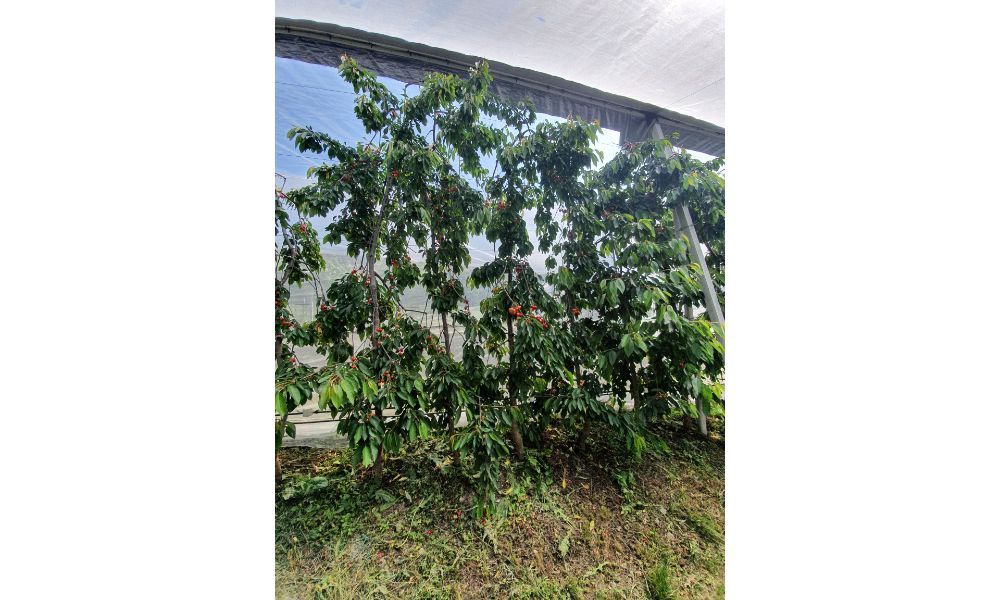
Tommaso Pantezzi - E. Mach Foundation (IT)
Cherry Times - Technical-scientific committee
Experimentation at the Mach Foundation's holdings on cherry orchards began in 2010 with the first plot planted at Maso delle Part thanks to the collaboration with Nicola Dallabetta. In 2010, the idea was to do a more intensive planting compared to the spacing commonly used in those years, when the spacing used was 4 x 2.
Based on the work carried out on the biaxis for apple trees, this form of training was tested and, thanks to contacts with American researchers, a wall form, called UFO, was added, similar in some respects to the guyot form also proposed for apple trees, a system that is relatively widespread in Chile and the United States. To evaluate the response, Gisela 5, and a somewhat more vigorous rootstock, Piku 1, were tested.
Interesting indications emerged from this first experimental plot, in particular on pruning management in the first few years, and experimentation was therefore continued with new forms of training, planting an experimental plot on the Vigalzano di Pergine farm in 2013, with two varieties, Kordia and Regina, grown with four different forms of training, at the distances deemed suitable, according to this chart:
BREEDING FORM | SPINDLE
| SUPERSPINDLE | BIBAUM | KGB/VASO | VARIETY | ROOTSTOCK |
DISTANCE | 1,4 m x 3,7 m | 0,7 m x 3,7 m
| 1,4 m x 3,7 m | 1,4 m x 3,7 m | KORDIA | GISELA 5 |
PLANTS/HA(9000M2) | 1750 plants | 3500 plants | 1750 plants | 1750 plants | REGINA | GISELA 5 |
Plants were set up according to the chosen breeding form, as opposed to the traditional spindle, starting from one-year old rods, except for the biaxis form, for which pre-formed biaxis plants found on the market were used.
Over the years, the main vegetative-productive data were collected from the plants, three fruit samples were weighed for each test plant and the quality characteristics of one fruit sample per randomised block were analysed.
Analysis of the data collected revealed some interesting indications for vegetative and productive aspects.
For both varieties, the final growth of the trunk section was the smallest for the superspindle bred plants, due to the greater competition between the plants that are bred at a smaller distance, followed by the spindle and KGB forms. The largest trunk section was measured on the biaxis, which is the sum of the section of the two axes measured individually.
As far as production aspects are concerned, the results of production per unit area are reported, as for this test it is considered a more suitable parameter to represent the result of the combination of planting shape and density.
Until 2022, the most productive forms of farming for Kordia were biaxis and superspindle, with 138 and 125 tonnes/ha respectively over nine years of production, compared to 91 for spindle and 83 for KGB.
 Kordia / columnar axis.
Kordia / columnar axis.
 Kordia / KGB pot.
Kordia / KGB pot.
 Kordia / Spindle. For Regina, the most productive breeding form was biase with 159 ton/ha, not statistically different from superspindle with 150 ton/ha. Slightly lower was spindle with 134 ton/ha, followed by KGB with 105 ton/ha.
Kordia / Spindle. For Regina, the most productive breeding form was biase with 159 ton/ha, not statistically different from superspindle with 150 ton/ha. Slightly lower was spindle with 134 ton/ha, followed by KGB with 105 ton/ha.
With regard to fruit size, no drop in size was observed in the most productive forms, with Kordia's weight fluctuating between 12.3 and 12.9 g/fruit on average, while Regina's weight fluctuated between 11.1 and 11.9 grams.
 Regina / Bibaum.
Regina / Bibaum.
The average grading performed at the delivery co-operative also did not result in major differences with 28+ fruit percentages averaging between 55% spindle and 62% biaxis for Kordia. For Regina, somewhat wider differences in sizing were observed, ranging from 30% obtained with spindle to 42% with biase and KGB.
From an internal fruit quality perspective, the differences observed were greater between the different seasons, although the level of soluble solids (sugars) tended to be slightly higher for Regina.
 Regina / Spindle.
Regina / Spindle.
Tommaso Pantezzi, Angela Gottardello
E. Mach Foundation (IT)
Cherry Times - All rights reserved
















